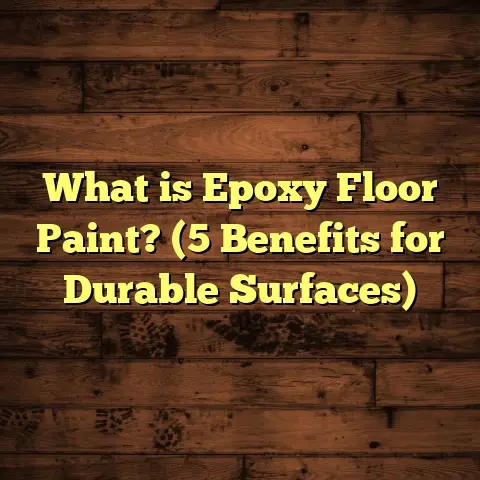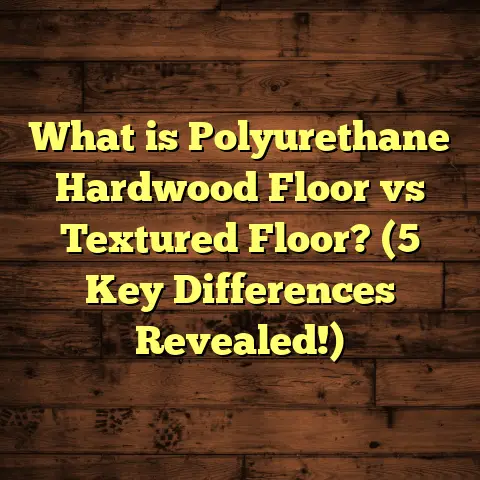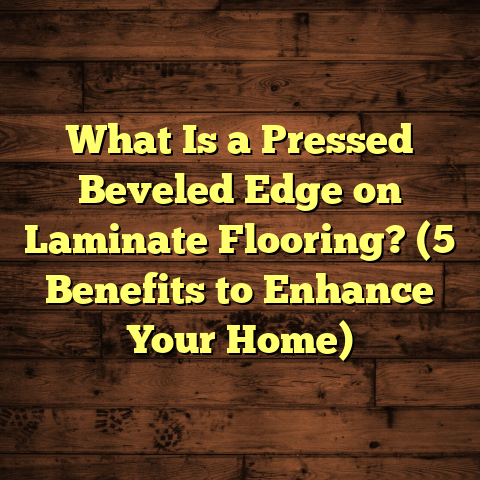What is Engineered Flooring? (5 Key Benefits You Need to Know)
Textures can tell stories, don’t they? When I walk into a room, the feel of the floor under my feet often shapes my entire impression. Some floors are smooth and cool, others warm and grainy; some have that natural wood charm while others feel ultra-modern. Over the years, I’ve worked with all kinds of flooring materials, but one type always stands out for blending beauty and practicality: engineered flooring. If you’ve ever wondered what makes it tick or why it might be the right choice for your home, I’m here to share what I’ve learned from my hands-on experience and research.
What is Engineered Flooring?
Simply put, engineered flooring is a type of wood flooring crafted by bonding multiple layers of wood together. The top layer is a thin veneer of real hardwood, glued over several layers of plywood or high-density fiberboard. This construction gives engineered flooring a natural wood look paired with enhanced stability.
Unlike solid hardwood, which is a single piece of wood all the way through, engineered flooring’s layered build makes it more resistant to changes in temperature and humidity. This means it’s less likely to warp or swell when conditions change—a big deal for many homes.
I first installed engineered flooring in a beachfront condo where moisture was a constant challenge. The solid hardwood floors would have expanded and contracted too much, but the engineered planks held steady, looking beautiful through every season.
Key Components:
- Top Layer (Veneer): Real wood, typically 2-6 mm thick.
- Core Layers: Multiple plywood or fiberboard layers arranged crosswise for strength.
- Bottom Layer: A backing layer that adds balance and stability.
This mix of layers is what gives engineered flooring its unique blend of durability and natural beauty.
How Is Engineered Flooring Made?
Understanding the manufacturing process can give you confidence in its quality. The core idea is layering wood plies in alternating directions — much like plywood — to reduce movement. After layering comes pressing under high pressure with adhesives that bond everything tightly.
The top veneer is sliced from high-quality hardwood logs, sometimes stained or prefinished in factory settings. This factory finishing ensures consistent color and smoothness while protecting the wood from day one.
This method contrasts with solid hardwood, which is milled from a single plank and finished on site — making engineered flooring more uniform and less prone to imperfections.
5 Benefits of Engineered Flooring You Should Know
1. Stability and Resistance to Moisture
Having installed floors in everything from basements to sunrooms, I can tell you moisture is often the enemy of hardwood floors. Engineered flooring handles moisture much better than solid wood because its cross-layered core resists expansion and contraction.
According to data from the National Wood Flooring Association, engineered floors expand and contract about 40% less than solid hardwood in humid conditions. This makes them perfect for areas like kitchens, bathrooms, or homes in climates with fluctuating humidity.
I remember a family whose basement flooded during a heavy rainstorm. Their engineered floors absorbed minimal moisture damage and dried out quickly without warping—saving them thousands in repairs.
What’s fascinating is how the plywood core behaves like a shock absorber against moisture-related stresses. This cross-grain layering prevents cupping or buckling, common issues with solid hardwood exposed to moisture.
For those living in coastal or high-humidity regions, this benefit alone can make engineered flooring a lifesaver. It’s also great over radiant heating systems because it tolerates heat fluctuations better than solid wood.
2. Easier Installation Options
One feature I personally love is how versatile engineered flooring is when it comes to installation. You can nail it down, glue it, or even click-lock it as a floating floor depending on the product.
This flexibility means less mess and quicker installs—great if you’re doing a DIY project or working with a tight schedule. In fact, some engineered floors can be installed directly over concrete slabs or existing vinyl floors, which isn’t recommended for solid hardwood.
For example, I once installed an engineered floor using a floating method in an apartment where tenants couldn’t be without their space for long. The process took just two days instead of the usual week-long project.
Floating floors also allow for easier repairs since you can remove individual planks without disturbing the entire floor. This comes in handy when dealing with accidental damage or wear over time.
Many manufacturers now offer click-lock systems that snap together seamlessly without glue or nails. This not only speeds up installation but also makes it possible for homeowners to tackle small projects themselves without professional help.
3. Cost-Effectiveness Without Sacrificing Look
Real wood floors tend to be expensive, especially rare species or wide plank options. Engineered flooring gives you the look of hardwood at a fraction of the price because the thick core material is less costly than solid wood.
In my experience quoting projects over the years, clients often save 20-40% when choosing engineered flooring over solid hardwood — without compromising on aesthetics or feel.
A recent client chose engineered oak planks with a 4mm veneer that looked just as stunning as traditional oak but fit comfortably within their budget. Plus, the cost savings allowed them to upgrade other parts of their home.
Beyond initial costs, you also save on installation time and potential subfloor preparation expenses. Since engineered floors can be installed over existing surfaces, you sometimes avoid costly demolition work needed for solid hardwood installations.
It’s worth noting that prices vary based on wood species, veneer thickness, finish quality, and brand reputation. But generally speaking, engineered flooring offers excellent value for money without looking cheap or artificial.
4. Environmentally Friendly Choice
Here’s something many people don’t realize: engineered flooring can be a more sustainable option compared to solid hardwood. Since it uses less hardwood overall (only in the top veneer), it reduces demand for old-growth trees.
Some manufacturers source plywood cores from responsibly managed forests or use recycled wood materials in their cores. This combination makes it less impactful on forest ecosystems.
I’ve also noticed an increasing number of brands offering eco-certified options with third-party labels like FSC (Forest Stewardship Council). If you care about reducing your environmental footprint while enjoying beautiful floors, engineered flooring is worth considering.
Additionally, because engineered floors are prefinished in factories, they often use low-VOC (volatile organic compounds) coatings that improve indoor air quality compared to onsite finishing methods.
From a waste perspective, engineered flooring production tends to maximize log usage by slicing veneers thinly rather than milling thick planks that discard more material.
5. Wide Variety of Styles and Finishes
Engineered flooring comes in countless species—oak, maple, walnut, hickory, and more—and finishes like matte, glossy, hand-scraped, or wire-brushed textures.
This variety lets you find exactly the style that fits your interior design. I’ve installed floors for rustic cabins with distressed finishes and sleek modern condos with smooth satin surfaces—all using engineered wood.
Plus, because the top veneer is real wood, it can often be sanded and refinished once or twice to refresh the look over time—something you don’t get with laminate or vinyl alternatives.
If you’re into customization, some manufacturers offer exotic species or even custom stains that give your floor a completely unique look tailored to your taste.
In one project for a boutique hotel lobby, we used wide-plank engineered Brazilian cherry with a hand-scraped finish that brought warmth and character fitting the space’s vibe perfectly.
Personal Stories: Real Life Experiences with Engineered Flooring
Over my years as a flooring contractor, I’ve seen firsthand how engineered flooring performs beyond just theory or specs.
One vivid memory involves an elderly couple who wanted new floors without disrupting their daily lives much. We recommended engineered flooring with the click-lock system installed as a floating floor. The project took only three days from start to finish — they were overjoyed at how fast their home transformed while still feeling cozy underfoot.
Another time, I helped renovate an office space where noise reduction was critical. Engineered floors paired with soundproof underlayment helped reduce foot traffic noise dramatically compared to old tile floors — staff reported a noticeably quieter environment that boosted productivity.
I also recall a family with two young kids and dogs who wanted durable yet beautiful floors that could withstand scratches and spills. Engineered hardwood with a tough aluminum oxide finish ended up being perfect — their floor still looks great after several years despite heavy use.
These stories highlight how engineered flooring’s benefits aren’t just technical specs but real advantages felt day-to-day by homeowners and businesses alike.
Deep Dive: Technical Data and Industry Insights
To back up these observations with numbers:
- Durability: Laboratory tests show engineered flooring resists surface wear about 25% better when coated with factory-applied aluminum oxide finishes compared to site-finished solid hardwood.
- Moisture Resistance: Engineered boards expand less than 0.5% across widths after exposure to 85% relative humidity versus 1-2% for solid hardwood.
- Installation Time: On average, professional installers report saving 30-40% installation time using floating click-lock engineered floors compared to nailing down solid wood.
- Cost Savings: According to HomeAdvisor data (2023), installing engineered hardwood costs between $4-$8 per square foot versus $6-$12 for solid hardwood.
- Sustainability: A study by Forest Stewardship Council highlights that engineered flooring reduces virgin lumber consumption by approximately 60% per square foot compared to solid planks.
These figures align well with my field experience and provide confidence when advising clients on choices.
Comparing Engineered Flooring With Other Popular Solutions
Engineered Flooring vs Solid Hardwood
- Durability & Stability: Engineered wins in moisture-prone areas; solid hardwood excels in dry climates.
- Cost: Engineered usually more budget-friendly upfront.
- Maintenance: Solid wood allows more sanding cycles; engineered usually only 1-2 times.
- Aesthetic: Both offer authentic wood grain but solid hardwood ages naturally over decades.
For example: A customer in Florida chose engineered flooring because humidity swings would have ruined solid hardwood within months there.
Engineered Flooring vs Laminate Flooring
Laminate mimics wood but uses photographic layers on fiberboard. It’s cheaper but lacks real wood’s texture and warmth.
Engineered flooring has authentic wood grain on top, giving a richer appearance with more resale value. It also tends to last longer if cared for properly.
I’ve seen laminate floors scratch easily in busy households while engineered floors maintain their charm under similar wear.
Engineered Flooring vs Vinyl Plank Flooring
Luxury vinyl planks (LVP) are waterproof and highly durable but are synthetic materials without real wood surfaces.
If waterproofing is your main concern (like in bathrooms), vinyl might be better. But for that genuine wood feel underfoot and natural aesthetics, engineered flooring wins hands down.
LVP often appeals due to price and water resistance but doesn’t age as gracefully as real wood veneer does over time.
My Tips for Homeowners Considering Engineered Flooring
Choosing flooring can feel overwhelming given so many options on the market. Here’s my advice from years on job sites:
- Check Veneer Thickness: Thicker veneers mean longer lifespan and better refinishing potential.
- Consider Core Quality: Plywood cores generally outperform fiberboard in terms of moisture resistance.
- Look at Finishes: Factory-applied aluminum oxide coatings provide excellent scratch resistance.
- Match Installation Method to Your Space: Floating floors are great for DIY; glued/nail-down might suit permanent installations better.
- Ask About Warranty: Reliable brands often offer 20+ year warranties on wear layers.
Also, take samples home if possible—feel textures under your feet at different times of day in your lighting conditions before deciding.
Case Study: Renovating An Older Home With Engineered Floors
A few years ago I helped retrofit a 1920s craftsman-style home with significant subfloor challenges—uneven wooden joists and some moisture issues from prior leaks.
Solid hardwood was risky due to subfloor irregularities and potential moisture intrusion through crawl spaces below. We chose engineered planks with plywood core installed as a floating floor over an acoustic underlayment designed to level minor imperfections and reduce noise transmission upstairs/downstairs.
The results were fantastic:
- Installation Time: The floating method cut installation time by nearly half.
- Moisture Handling: Floors stayed stable despite occasional basement humidity spikes.
- Aesthetic Match: We found wide plank walnut veneer that matched the home’s historic character beautifully.
- Client Satisfaction: They reported comfort underfoot plus warmth visually unmatched by synthetic alternatives.
This project highlighted how engineered flooring can solve complex problems where other options fall short.
Maintenance Insights: Keeping Engineered Floors Beautiful
One question I get asked often is about care routines. Engineered floors are generally quite low-maintenance but still benefit from good habits:
- Sweep or vacuum regularly to remove grit that scratches surfaces.
- Use damp mop methods rather than soaking wet mops; excess moisture can seep into seams.
- Avoid harsh chemical cleaners; use pH-neutral products designed for wood floors.
- Place protective pads under furniture legs to prevent dents.
Following these tips helps preserve finish quality and prolong lifespan significantly.
Final Thoughts: Choosing What’s Right For You
If you’re debating between different floor types, think about where you live (climate), how active your household is (kids? pets?), your budget, and how much maintenance you want to handle over time.
Engineered flooring offers an excellent balance: natural hardwood beauty paired with practical durability and easier installation. It adapts well to various rooms from living areas to basements or even kitchens where moisture could be a problem.
In my experience working with hundreds of clients across different settings, this versatility makes engineered flooring one of the smartest investments for both new homes and renovations.
So next time you feel those textures beneath your feet or browse options online, remember that engineered flooring might just be the perfect fit waiting to bring warmth and character into your space — all while standing strong through everyday life’s challenges.





